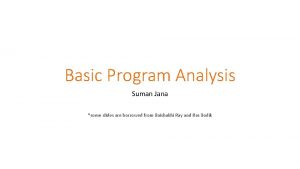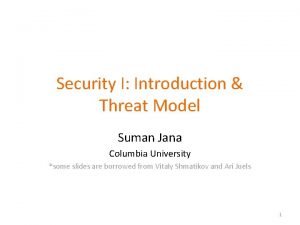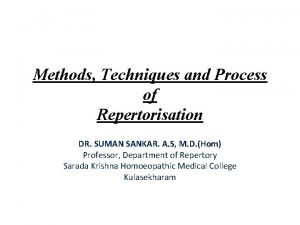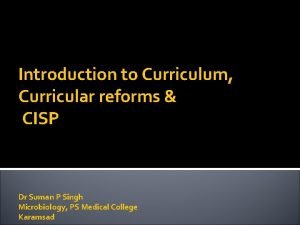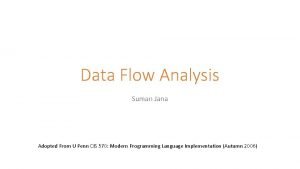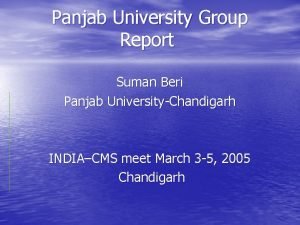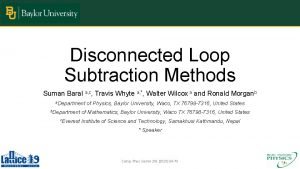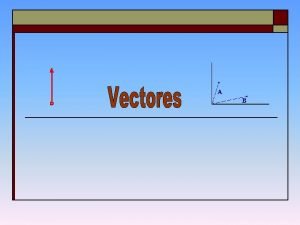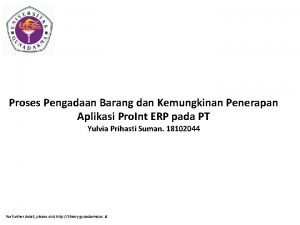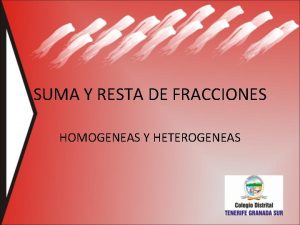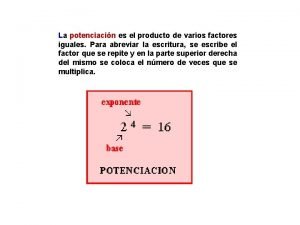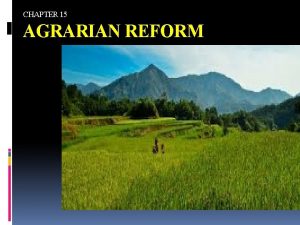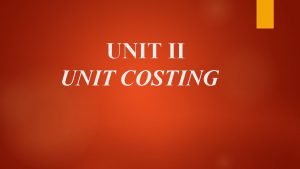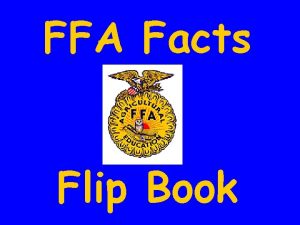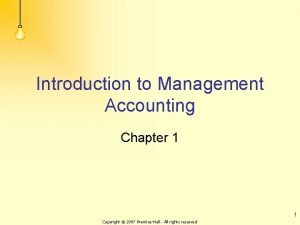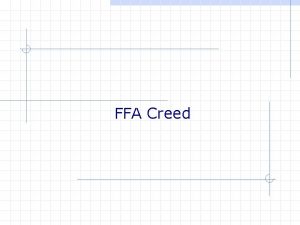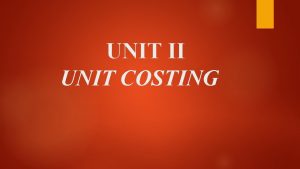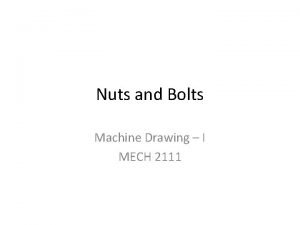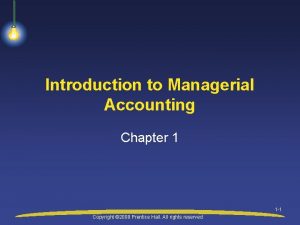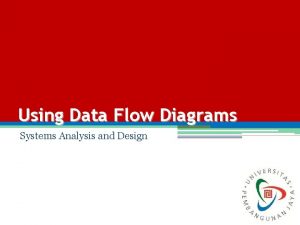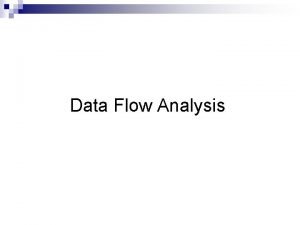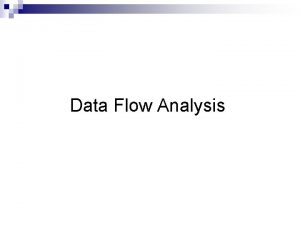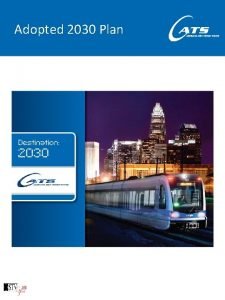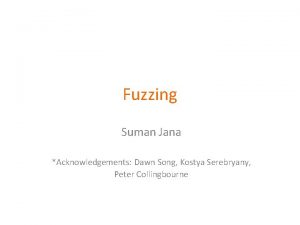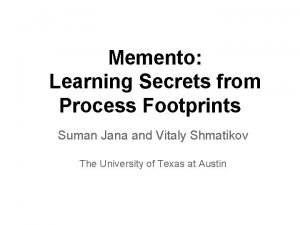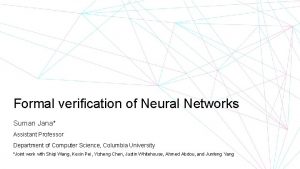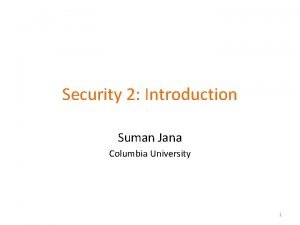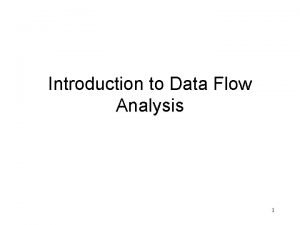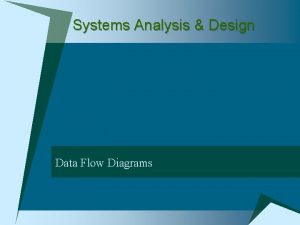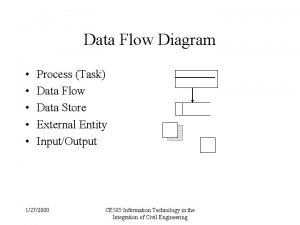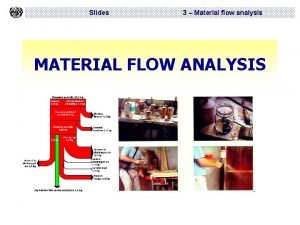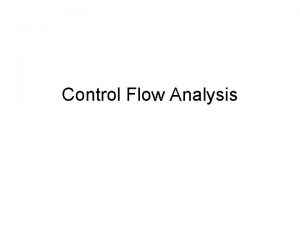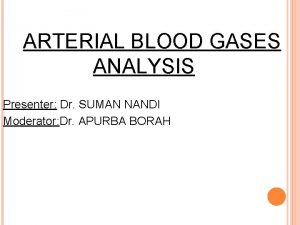Data Flow Analysis Suman Jana Adopted From U












![Computing Liveness • Generate liveness: If a variable is in use[n], it is live-in Computing Liveness • Generate liveness: If a variable is in use[n], it is live-in](https://slidetodoc.com/presentation_image_h/eaf6fe3d093ba98609ccb9f670f0b44c/image-13.jpg)
![Solving Dataflow Equation for each node n in CFG Initialize solutions in[n] = ∅; Solving Dataflow Equation for each node n in CFG Initialize solutions in[n] = ∅;](https://slidetodoc.com/presentation_image_h/eaf6fe3d093ba98609ccb9f670f0b44c/image-14.jpg)











![Computing Reaching Definition • Assumption: At most one definition per node • Gen[n]: Definitions Computing Reaching Definition • Assumption: At most one definition per node • Gen[n]: Definitions](https://slidetodoc.com/presentation_image_h/eaf6fe3d093ba98609ccb9f670f0b44c/image-26.jpg)







- Slides: 33

Data Flow Analysis Suman Jana Adopted From U Penn CIS 570: Modern Programming Language Implementation (Autumn 2006)

Data flow analysis • Derives information about the dynamic behavior of a program by only examining the static code • Intraprocedural analysis • Flow-sensitive: sensitive to the control flow in a function • Examples – Live variable analysis – Constant propagation – Common subexpression elimination – Dead code detection 1 a : = 0 2 L 1: b : = a + 1 3 4 5 6 c : = c a : = b if a < return + b * 2 9 goto L 1 c • How many registers do we need? • Easy bound: # of used variables (3) • Need better answer

Data flow analysis • Statically: finite program • Dynamically: can have infinitely many paths • Data flow analysis abstraction • For each point in the program, combines information of all instances of the same program point

Example 1: Liveness Analysis

Liveness Analysis Definition –A variable is live at a particular point in the program if its value at that point will be used in the future (dead, otherwise). –To compute liveness at a given point, we need to look into the future Motivation: Register Allocation –A program contains an unbounded number of variables – Must execute on a machine with a bounded number of registers –Two variables can use the same register if they are never in use at the same time (i. e, never simultaneously live). –Register allocation uses liveness information

Control Flow Graph • Let’s consider CFG where nodes contain program statement instead of basic block. • Example 1. 2. 3. 4. 5. 6. a : = 0 L 1: b : = a + 1 c: = c + b a : = b * 2 if a < 9 goto L 1 return c 1. a = 0 2. b = a + 1 3. c=c+b 4. a=b*2 5. No 6. return c a<9 Yes

Liveness by Example • Live range of b 1. a = 0 • Variable b is read in line 4, so b is live on 3 ->4 edge • b is also read in line 3, so b is live on (2 ->3) edge • Line 2 assigns b, so value of b on edges (1 ->2) and (5 ->2) are not needed. So b is dead along those edges. • b’s live range is (2 ->3 ->4) 2. b = a + 1 3. c=c+b 4. a=b*2 5. No 6. return c a<9 Yes

Liveness by Example • Live range of a 1. a = 0 • (1 ->2) and (4 ->5 ->2) • a is dead on (2 ->3 ->4) 2. b = a + 1 3. c=c+b 4. a=b*2 5. No 6. return c a<9 Yes

Terminology • Flow graph terms • A CFG node has out-edges that lead to successor nodes and in-edges that come from predecessor nodes • pred[n] is the set of all predecessors of node n • succ[n] is the set of all successors of node n 1. a = 0 2. b = a + 1 Examples – Out-edges of node 5: (5 6) and (5 2) – succ[5] = {2, 6} – pred[5] = {4} – pred[2] = {1, 5} 3. c=c+b 4. a=b*2 5. No 6. return c a<9 Yes

Uses and Defs Def (or definition) –An assignment of a value to a variable –def[v] = set of CFG nodes that define variable v –def[n] = set of variables that are defined at node n Use –A read of a variable’s value –use[v] = set of CFG nodes that use variable v –use[n] = set of variables that are used at node n More precise definition of liveness – A variable v is live on a CFG edge if (1) a directed path from that edge to a use of v (node in use[v]), and (2)that path does not go through any def of v (no nodes in def[v]) a = 0 a < 9 v live def[v] use[v]

The Flow of Liveness • Data-flow • Liveness of variables is a property that flows through the edges of the CFG • Direction of Flow • Liveness flows backwards through the CFG, because the behavior at future nodes determines liveness at a given node 1. a = 0 2. b = a + 1 3. c=c+b 4. a=b*2 5. No 6. return c a<9 Yes

Liveness at Nodes Just before computation 1. a = 0 Just after computation 2. b = a + 1 Two More Definitions – A variable is live-out at a node if it is live on any out edges 3. c=c+b 4. a=b*2 – A variable is live-in at a node if it is live on any in edges 5. No 6. return c a<9 Yes
![Computing Liveness Generate liveness If a variable is in usen it is livein Computing Liveness • Generate liveness: If a variable is in use[n], it is live-in](https://slidetodoc.com/presentation_image_h/eaf6fe3d093ba98609ccb9f670f0b44c/image-13.jpg)
Computing Liveness • Generate liveness: If a variable is in use[n], it is live-in at node n • Push liveness across edges: • • If a variable is live-in at a node n then it is live-out at all nodes in pred[n] • Push liveness across nodes: • If a variable is live-out at node n and not in def[n] • then the variable is also live-in at n • Data flow Equation: in[n] = use[n] (out[n] – def[n]) out[n] = in[s] s succ[n]
![Solving Dataflow Equation for each node n in CFG Initialize solutions inn Solving Dataflow Equation for each node n in CFG Initialize solutions in[n] = ∅;](https://slidetodoc.com/presentation_image_h/eaf6fe3d093ba98609ccb9f670f0b44c/image-14.jpg)
Solving Dataflow Equation for each node n in CFG Initialize solutions in[n] = ∅; out[n] = ∅ repeat for each node n in CFG in’[n] = in[n] Save current results out’[n] = out[n] in[n] = use[n] ∪ (out[n] – def[n]) Solve data-flow equation out[n] = ∪ in[s] s ∈ succ[n] until in’[n]=in[n] and out’[n]=out[n] for all n Test for convergence

Computing Liveness Example 1. a = 0 2. b = a + 1 3. c=c+b 4. a=b*2 5. No 6. return c a<9 Yes

Iterating Backwards: Converges Faster 1. a = 0 2. b = a + 1 3. c=c+b 4. a=b*2 5. No 6. return c a<9 Yes

Node use Liveness Example: Round 1 A variable is live at a particular point in the program if its value at that point will be used in the future (dead, otherwise). 1. a = 0 6 c 5 a 4 b a 3 bc c 2 a b 1 2. b = a + 1 3. c=c+b 4. a=b*2 5. No 6. return c a<9 Yes def a

Node use Liveness Example: Round 1 in: c out: ac in: ac out: bc 1. a = 0 out: ac 6. return c c 5 a 4 b a 3 bc c 2 a b a 2. b = a + 1 4. 5. No 6 1 3. in: bc def c=c+b in: bc out: bc Yes a=b*2 a<9 in: c in: ac out: c

Node use Liveness Example: Round 1 in: c out: ac in: ac out: bc 1. a = 0 out: ac 6. return c c 5 a 4 b a 3 bc c 2 a b a 2. b = a + 1 4. 5. No 6 1 3. in: bc def c=c+b in: bc out: bc Yes a=b*2 a<9 in: c in: ac out: ac

Conservative Approximation 1. a = 0 2. b = a + 1 Solution X: - From the previous slide 3. c=c+b 4. a=b*2 5. No 6. return c a<9 Yes

Conservative Approximation 1. a = 0 2. b = a + 1 Solution Y: Carries variable d uselessly – Does Y lead to a correct program? 3. c=c+b 4. a=b*2 5. a<9 No 6. return c Imprecise conservative solutions ⇒ sub-optimal but correct programs Yes

Conservative Approximation 1. a = 0 2. b = a + 1 Solution Z: Does not identify c as live in all cases – Does Z lead to a correct program? c=c+b 4. a=b*2 5. No 6. return c Non-conservative solutions ⇒ incorrect programs 3. a<9 Yes

Need for approximation • Static vs. Dynamic Liveness: b*b is always non-negative, so c >= b is always true and a’s value will never be used after node No compiler can statically identify all infeasible paths

Liveness Analysis Example Summary • Live range of a • (1 ->2) and (4 ->5 ->2) 1. a = 0 • Live range of b 2. b = a + 1 • (2 ->3 ->4) • Live range of c • Entry->1 ->2 ->3 ->4 ->5 ->2, 5 ->6 You need 2 registers Why? 3. c=c+b 4. a=b*2 5. No 6. return c a<9 Yes

Example 2: Reaching Definition
![Computing Reaching Definition Assumption At most one definition per node Genn Definitions Computing Reaching Definition • Assumption: At most one definition per node • Gen[n]: Definitions](https://slidetodoc.com/presentation_image_h/eaf6fe3d093ba98609ccb9f670f0b44c/image-26.jpg)
Computing Reaching Definition • Assumption: At most one definition per node • Gen[n]: Definitions that are generated by node n (at most one) • Kill[n]: Definitions that are killed by node n {y, i}

Data-flow equations for Reaching Definition

Recall Liveness Analysis • Data-flow Equation for liveness • Liveness equations in terms of Gen and Kill Gen: New information that’s added at a node Kill: Old information that’s removed at a node Can define almost any data-flow analysis in terms of Gen and Kill

Direction of Flow

Data-Flow Equation for reaching definition

Available Expression • An expression, x+y, is available at node n if every path from the entry node to n evaluates x+y, and there are no definitions of x or y after the last evaluation.

Available Expression for CSE • Common Subexpression eliminated • If an expression is available at a point where it is evaluated, it need not be recomputed

Must vs. May analysis • May information: Identifies possibilities • Must information: Implies a guarantee May Must Forward Reaching Definition Available Expression Backward Live Variables Very Busy Expression
 Dr suman jana
Dr suman jana Dr suman jana
Dr suman jana Dr suman jana
Dr suman jana Cisp mci
Cisp mci Dr suman jana
Dr suman jana Dr suman jana
Dr suman jana Data flow vs control flow
Data flow vs control flow Control flow and data flow computers
Control flow and data flow computers En una industria construyen un tanque de forma conica
En una industria construyen un tanque de forma conica Suman beri
Suman beri Dr suman baral
Dr suman baral Suman armitage
Suman armitage Vectores
Vectores Yulvia prihasti suman
Yulvia prihasti suman Dr suman sharma
Dr suman sharma Sumó las fracciones homogéneas
Sumó las fracciones homogéneas Tres factores iguales a 5
Tres factores iguales a 5 Andre suman kanban
Andre suman kanban Scrap account
Scrap account What is the ffa creed
What is the ffa creed Compras y vandalas meaning
Compras y vandalas meaning Unit cost meaning
Unit cost meaning Who wrote the ffa creed? when was it adopted?
Who wrote the ffa creed? when was it adopted? What are the ffa colors
What are the ffa colors Drug basket method is used in
Drug basket method is used in Process adopted for curriculum development in pakistan
Process adopted for curriculum development in pakistan Who wrote the ffa creed when was it adopted
Who wrote the ffa creed when was it adopted The institute of management accountants adopted the ______.
The institute of management accountants adopted the ______. Ffa creed assignment
Ffa creed assignment The method of unit costing is adopted by
The method of unit costing is adopted by Assembly drawing
Assembly drawing When was the ffa creed adopted and amended
When was the ffa creed adopted and amended Managerial accounting chapter 1
Managerial accounting chapter 1 Data flow diagram in system analysis and design
Data flow diagram in system analysis and design
